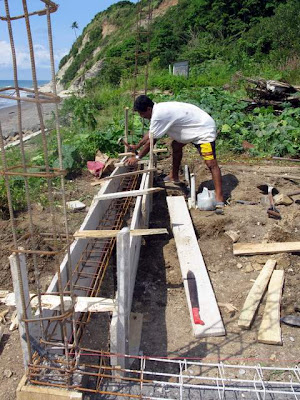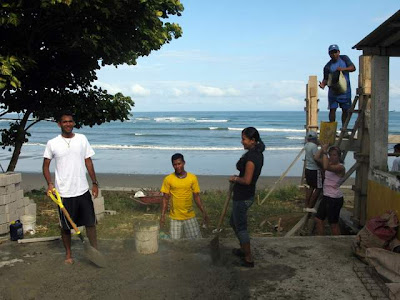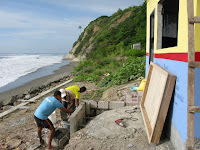I made the design and was in charge of all construction, testing, and promotion. Workers included the two maestros we hired, volunteers from other organizations, surfers, my visiting fiancé, and various men, women, and children of Estero. Funding came from Fundación Agua Muisne and Fundación Yanapuma.
Enjoy the photo report below; I'd be happy to answer your questions!
Before Construction
Before any construction began, we held town meetings to educate people on the importance of clean water, announce the commencement of the project, and ask the community for assistance in the form of voluntary labor. Then, we gathered requirements, evaluated potential sites, agreed on a location, and I created the design in Google SketchUp.
 |
| We selected a nice, semi-flat field between the school and the sea. Best work site ever! |
Week 1
 |
| In the first week, we built the foundation, footing, columns, and floor (lots of digging and mixing cement) |
Below: Dug holes, leveled foundation trenches, inserted reinforcing steel for tensile strength, and built molds

Volunteers helped to mix and pour cement - a good way to grow muscles

Completed the foundation, footing, columns, and floor with hardcore filling underneath
We also dug trenches and installed all underground pipes for water intake and drainage. We named the sleeveless guy pictured above, "Machina". He showed up one day and astounded us with his machine-like pace of work. On the right is Maestro Jesus, a man who takes pride in and thoroughly enjoys his work.
Week 2
 |
| Maestro Arturo, building the rafters |
We plastered the walls, both inside and out, using good sand from the beach, with help from volunteers. In the photo to the right you see two 9-month American volunteers from Fundación Yanapuma: Standing next to me is Nik, a future doctor and trusty friend to all, and in the wheelbarrow is Allie, Positive Force of Estero. I will describe more the contributions and roles of foreign volunteers here in a future post. The girls by Allie are not only the most beautiful in town, but are scholarship students, and just two of six sisters. Julio, there on the left, one of my boyz, was elected President by the town, but he has rejected the position for now, feeling he is too young. He is also the best soccer player (amongst many incredible players), best dancer, and best worker.
 |
| View of the steps, taps, and interior (with roof removed). We worked all seven days this week. |
Completed the walls, prepared openings for the windows and door
 |
| Built steps leading to the boardwalk |
We increased height of platform (above) and built a high platform for the outside tank (right). Gravity was used for pressure whenever possible, allowing us to only need one small pump for pushing water through the filters, into a final storage tank and nothing more. Even in times without electricity (quite often), our system can have ready enough clean drinking water to last the entire town three days.
Ruth (left) preparing a bucket of whitewash. After plastering, all walls were whitewashed.
 |
| The steps and floors are under a layer of red pulvo (a solution made from powder that prevents water from entering and weakening the cement) |
 |
| Plumbing ain't easy! Tanks, pipes and fittings were installed for the filling of tanks, delivery to filters and taps, and drainage for cleaning. |
 |
| We held separate meetings with town leaders and scholarship students to begin publicizing the system |
Painting finally begins! (the UCLA blue and gold are not an accident. Coincidentally, the neighboring school had just been painted horrible Trojan colors. Muy feo. Our system looked good before, but standing next to the school... beautiful.)
Week 4
The window, made by a local carpenter, and a metal door were installed. (left) We also built a patio and
filling station down at the level of the board walk - easy access for anybody needing water. (right)
 |
| Inner walls were whitewashed, and a layer of blue enamel paint was added to the bottom to prevent water from entering |
 |
| We added a red stripe to make the colors of Ecuador |
 |
| "Todo bien y listo!" says Heriberto |
After Construction - Inauguration, 4-25-2011
Finally the day arrived, where the system was completely ready. For days and days, we would say "almost there" or "just a bit more to go". I felt relief and a hint of disbelief that there was nothing more to be built, fixed, or cleaned. Some friends and I went door to door telling people about the inauguration - the whole town was invited. As people began arriving, I answered questions and gave tours of the system, explaining how it functioned.
For over an hour, I filled sample cups for everyone to try our water. They liked the taste and nobody got sick thankfully! We gave free water out for the rest of the day, and many people came with their own buckets to fill.
Of course, along with the good hard work, un-hurried pace,
and making of new friends, we did have problems, delays, minor frustrations. Keeping moral up was one of my primary goals. Sometimes certain materials were needed but unavailable, and transportation to town was unfeasible/impossible. Or a particular
job set us back, requiring an extra long day. We
had many days where big meals were eaten afterwards in silence. Meeting our timeline and budget took resourcefulness and coming up with on-the-spot solutions.
Simply having the design helped us avoid much confusion,
giving a standard to discuss and plan around each day. All in all,
technical problems all have their workarounds; this is what I do well. But technical problems are just half the story… the other half, the social aspect, proved to be a more ambiguous and taxing. Here, I felt I did not do as well as I wanted to, and see much room for improvement.
More in the next post.
































A great post! Congratulations to you and your team for such an accomplishment out there, you really built something to be proud of! By the way, you forgot something else that will take a place in 4 weeks... Your wedding! Cant wait!
ReplyDeleteThanks, May. Wow you read fast - I was still making a couple edits haha. Added a couple pics. Thanks for following!!
ReplyDeleteYes, I am proud of it, but it is worthless if it goes unused. So I am continuing to work with the people on the ground over there to publicize and educate.
This was an awesome read. Can't wait to talk to you about it!
ReplyDeleteYou're on my RSS feed dude! See you soon!
ReplyDeletePhilip, such a treat to read. And just as May mentioned, congratulations on the completion of such an impressive project.
ReplyDeleteThank you!
ReplyDeleteWow, way to go! It's amazing to see this happen after literally years of attempts. I'm starting my water quality assessment in a few weeks, so hopefully we'll be getting some info on where people are getting their water now (hopefully from the new system!!)
ReplyDeleteThis is accurate. This is fun. This is an incredible undertaking and accomplishment from everybody involved, especially Philip.
ReplyDeleteI collaborated with Philip on this project. He taught me a lot of things about the engineering of the system and how to get the good sand to make sturdier cement. But he also taught me to 'make everyday a masterpiece.' He was up earlier, surfed more, sweat harder and smiled wider than the larger majority of us down there. With that came the most important thing in the world: clean water... how neat is that!?
Incredible! Excellent pictures and 3D models. That is what it's all about - turning good ideas into reality. I'm curious to know how much use it gets.
ReplyDelete